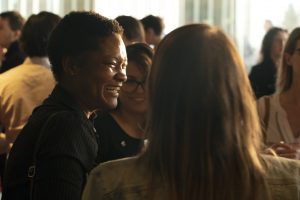
More than 200 scientists and entertainment professionals gathered on the second floor of the Creative Artists Agency in Century City sipping on wine and getting to know one another as they waited for the main event of the night to begin. Everyone had been given a vintage motel key with a numbered plastic tag at check-in, which would come in handy later when the crowd would be split up into small groups.
Welcome to another exciting edition of The Exchange’s Science Speed Dating, where seven scientists have exactly seven minutes to explain their research to one group before being ousted to the next. After roughly an hour of rotating speakers in this round-robin style, each group has heard seven quick-fire talks on wildly different subjects. Finally, the evening culminates in a wrap-up panel discussion with all seven scientists and a moderator.
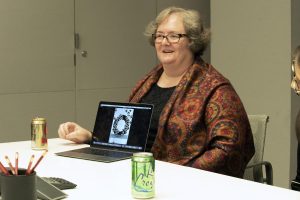
Andrea Bertozzi
As part of group 7, my first “date” was UCLA applied mathematician Andrea Bertozzi, who offered us a choice of what she could talk about. Did we want to hear about crime or swarming robots? The response overwhelmingly leaned toward the latter, a topic she has been studying since having an epiphany on 9/11. Her career had focused on fluid dynamics at the time, but fueled by her desire to help her country, Bertozzi decided to switch gears and work on the mathematics of swarming for the U.S. Department of Defense. Her lab has created ground-based robotic bees and is studying algorithms that could send out a swarm to pollinate certain plants.
Bertozzi’s seven minutes flew by, and before we knew it, she was replaced by UCSB theoretical astrophysicist Lars Bildsten. He quickly shifted the focus of the room from swarms to space: “I work on stars. So as I like to say, you’re about to get stars with Lars.” He talked about NASA’s Kepler Space Telescope, which measures the brightness of distant stars every 30 minutes or so over the span of several years. By detecting very slight oscillations in its brightness, scientists can deduce a star’s size, mass, and distance from Earth.
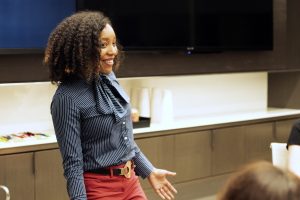
Moo Stricker
As Bildsten was escorted out, Moogega Stricker came into the room and continued the conversation about space from an engineer’s perspective. As a Planetary Protection Engineer at NASA’s Jet Propulsion Laboratory, she develops sterilization capabilities for space missions. Currently, she serves as the Lead of Planetary Protection for the Mars 2020 Mission, which means it is her job to make sure that Earth bacteria do not hitch a ride on the rover being sent to Mars. That way, NASA does not mistakenly find life on Mars that actually came from our own planet.
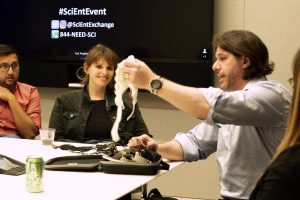
Ricardo Gil-da-Costa
At the halfway point of the evening, Neuroverse CEO Ricardo Gil-da-Costa brought the discussion back to Earth by dispelling a common myth about the human brain. “When someone wants to look really cool at a cocktail party and says, ‘Did you know we only use 10% of our brain?’ tell them they are an idiot.” We always use our entire brain, he says, and different parts of the brain work together through neural networks. His startup Neuroverse has developed a compact wireless EEG device called the BrainStation, which he passed around the room. It is currently in clinical trials for patients with migraines, Alzheimer’s disease, Parkinson’s disease, and other conditions.
The next speaker, UC Irvine genetic engineer Anthony A. James, applies gene-based technologies to insects that transmit diseases. The idea is to create genes that, when inserted into the mosquito genome, will prevent malaria parasites from developing and being transmitted. His work received a considerable boost with the advent of CRISPR, a revolutionary genome editing technology that can rapidly spread engineered genes through a population of insects through a method called gene drives.
The conversation moved from genetic engineering to computer engineering with a quick-fire talk by Google’s Kim Swennen. As a software engineer, she writes code that helps YouTube’s channel subscriptions run correctly—but she was not always interested in coding as a career. Swennen began as a theater studies major who specialized in Shakespeare and later worked as an actor in the entertainment industry for many years. She decided to completely switch fields, got a master’s degree in computer science from UCLA, and ended up at Google. Her talk emphasized that engineering is not rocket science, you do not necessarily need a Ph.D. to do it, and failure can be a wonderful teacher.
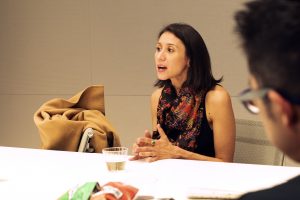
Adriana Galvan
The quick-fire portion of the event rounded out with UCLA neuroscientist Adriana Galvan, who spoke about maturity as characterized by changes in the human brain. For instance, the prefrontal cortex, a region that helps us make choices and plan for the future, does not mature until age 25. In this case, maturity is defined as the lack of plasticity in the brain. Over time, we lose the ability to take in new information quickly, which is why learning a language is so much easier as a child than as an adult. In another example by Galvan, the adolescent brain is very plastic because that is the period of our lives when we need to take risks and learn quickly before becoming a fully independent adult.
The sampling of quick-fire talks from such a diverse group of scientists left many of us craving more information on the subjects. All in all, we left the event with our minds full of new ideas and inspiration—while already looking forward to our next round of “dates.”






